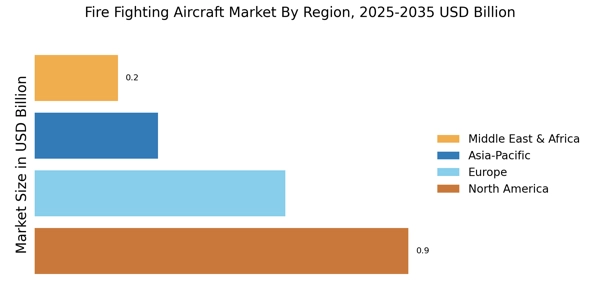Government Funding and Support
Government initiatives play a pivotal role in shaping the Fire Fighting Aircraft Market. Many countries allocate substantial budgets for firefighting resources, including aircraft, to enhance their emergency response capabilities. For example, recent budgets have shown a marked increase in funding for aerial firefighting programs, reflecting a commitment to improving public safety. This financial support not only facilitates the acquisition of advanced firefighting aircraft but also encourages research and development in this sector. As governments recognize the importance of effective firefighting strategies, the market is poised for growth, driven by enhanced funding and support.
Increasing Frequency of Wildfires
The rising incidence of wildfires is a critical driver for the Fire Fighting Aircraft Market. As climate change continues to exacerbate weather conditions, regions that were previously less prone to wildfires are now experiencing significant fire events. For instance, the National Interagency Fire Center reported that the number of acres burned in the United States has increased dramatically over the past decade. This trend necessitates the deployment of specialized aircraft designed for firefighting, thereby expanding the market. The demand for effective aerial firefighting solutions is likely to grow as authorities seek to mitigate the impact of these disasters, leading to increased investments in fire fighting aircraft.
Expansion of Private Sector Involvement
The involvement of private companies in firefighting efforts is reshaping the Fire Fighting Aircraft Market. Private firms are increasingly partnering with government agencies to provide aerial firefighting services, which enhances operational capacity and efficiency. This trend is evident in various regions where private contractors offer specialized aircraft and trained personnel to assist in firefighting operations. The collaboration between public and private sectors not only increases the availability of firefighting resources but also fosters innovation in aircraft technology. As this partnership model gains traction, it is likely to drive market growth and diversify the range of services offered.
Rising Awareness of Environmental Protection
The growing emphasis on environmental conservation is influencing the Fire Fighting Aircraft Market. As communities become more aware of the ecological impacts of wildfires, there is a heightened demand for sustainable firefighting solutions. This includes the use of eco-friendly fire retardants and aircraft that minimize environmental damage during operations. Furthermore, regulatory bodies are increasingly mandating the adoption of environmentally responsible practices in firefighting. Consequently, manufacturers are focusing on developing aircraft that align with these sustainability goals, which may lead to a shift in market dynamics as stakeholders prioritize eco-conscious solutions.
Technological Innovations in Aircraft Design
Technological advancements are transforming the Fire Fighting Aircraft Market. Innovations such as improved water delivery systems, enhanced maneuverability, and the integration of drones for reconnaissance are becoming increasingly prevalent. These advancements allow for more efficient and effective firefighting operations. For instance, the development of aircraft equipped with precision drop systems enables firefighters to target specific areas with greater accuracy, minimizing collateral damage. As technology continues to evolve, the market is likely to see a surge in demand for modern firefighting aircraft that incorporate these cutting-edge features, thereby enhancing operational effectiveness.


















Leave a Comment